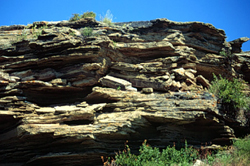First Peoples Buffalo Jump State Park
 First Peoples Buffalo Jump State Park
First Peoples Buffalo Jump State Park
For more than a thousand years native American men and women of the Great Plains hunted bison by driving them over cliffs. Buffalo jumps or "pishkuns" are found throughout Montana, east of the Continental Divide. The two most accessible buffalo jumps are the Madison Buffalo Jump, near Three Forks and First Peoples Buffalo Jump State Park, near Great Falls. "Pishkun" comes from the Blackfeet word meaning "deep blood kettle." The sites were suitably named; scores of bison were driven over the cliffs and slaughtered.
It is estimated that as many as 13 million bison or bison once lived in Montana. Bison could be found grazing almost anywhere east of the Divide. The best bison country was from the Rocky Mountain Front, near Glacier Park, east along the highline, across the Missouri River, into the grass-rich valleys of the Musselshell and the Yellowstone rivers.
The bison is Montana's largest wild animal, with old bulls growing to almost a ton in weight. (About the same as a medium sized pick-up truck.) They are members of the same family from which domestic cattle evolved. Females are called "cows" and the young are called "calves." Cows typically have one calf each spring, the largest of North American wildlife babies, weighing 30 to 40 pounds at birth.
To the nomadic Plains Indians bison meant survival. Bison provided meat to eat and hides for clothing and lodge coverings. The bones were used in making a variety of implements and utensils. The sinews were used for bowstrings and in sewing.
Before the Indians had the horse, skillful hunters were able to harvest the enormous animals by stalking them with bow and arrows and using the pishkun (buffalo jump). In the late nineteenth century, white fur traders and buffalo hunters with horses and guns nearly brought the buffalo to extinction. The Indians' way of life was changed forever.
Archaeologists describe five features of a pishkun. The first part is the grazing area where the Indians would find the buffalo, usually upwind from the camp and buffalo jump. The second feature was the "drive lane." It consisted of two rock lines, 5 to 10 yards apart and from 100 yards to 1 mile in length. Only a foot or so in height, these lines established the boundaries of the path the buffalo would follow to the precipice. Hunters hid behind the rock piles and shouted or waved robes to frighten the buffalo on toward the jump. The third feature, the cliff itself, could be 30 to 50 feet above the fourth feature, a rocky slope where the Indians killed the bison that survived the fall. Long bows, lances, and stone clubs were used to make the final kill. This is also where the Indians would dress the bison and dry their meat and hides. The process often took several days. The last feature was the camp where the people lived while they harvested the buffalo.
Recently, archaeologists from Montana State University researched and excavated the First Peoples Buffalo Jump State Park site. They discovered:
- First Peoples Buffalo Jump State Park is perhaps the largest buffalo jump in the world.
- Human activity at the site dates back to at least 500 AD.
- Buffalo apparently were killed and processed throughout the year, not just fall or winter, as previously believed.
How to Find It!
First Peoples Buffalo Jump State Park is located west of Great Falls. Take Ulm exit, 10 miles south of town on I-15, then 4 miles northwest on county road.
For more information and maps visit the Montana Fish, Wildlife and Parks listing for First Peoples Buffalo Jump State Park.

